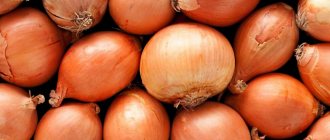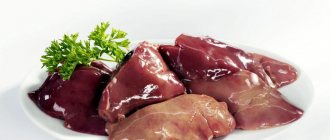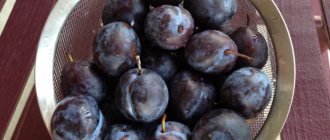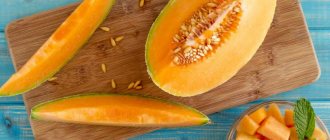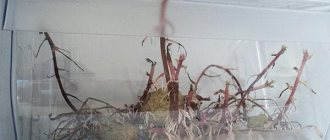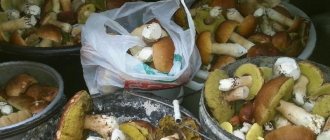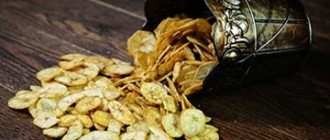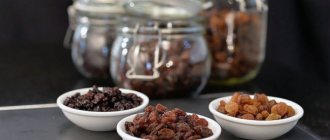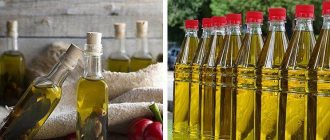Chemical composition of prunes
It is not for nothing that it is called a medicinal berry.
It deserves it because it contains a lot of vitamins and minerals. Vitamins: A, B1, B2, B3, B5, B6, B9, C, E, K, PP.
Macroelements: potassium, calcium, magnesium, sodium, phosphorus, chlorine.
Microelements: iron, manganese, copper, selenium, zinc.
In addition, it contains phenols, protein, fats, carbohydrates (57 g per 100 g), sorbitol, pectin, nitrogenous substances and fiber. You probably don’t need to mention glucose - as you know, the berry is very sweet. This whole storehouse of valuable substances, if used correctly, will bring a lot of benefits to the health of the body.
The calorie content of prunes is 264 kcal per 100 g.
The daily norm of prunes is 6 pcs.
The glycemic index of pitted prunes is 25-29 .
Useful properties and benefits of prunes for the body
- has antibacterial and antiseptic properties,
- cancer prevention,
- boosts the immune system,
- supports the cardiovascular system,
- helps with hypertension,
- prevention of anemia,
- improves metabolism,
- eliminates constipation,
- has a choleretic and diuretic effect,
- prevention and treatment of eye diseases,
- improves vision,
- strengthens the musculoskeletal system,
- activates brain function,
- improves performance and memory,
- helps restore strength,
- energizes, tones,
- fights stress,
- has a rejuvenating effect,
- improves skin condition.
It has long been noted that prunes prevent the development of cardiovascular diseases such as hypertension if consumed in the initial stages of the disease. And it copes with this better than many other fruits, berries and medicinal herbs. Therefore, to eliminate this disease, you need to include dried fruits in your daily diet.
The product has also been proven to have antibacterial properties. Moreover, it kills pathogenic bacteria that are present in the mouth - staphylococci and streptococci. This type of dried fruit will protect your teeth from caries.
But that's not all. Various studies have shown that plums strengthen bone tissue. Thus, it has been recommended that prunes be consumed by people exposed to radiation, such as astronauts and cancer patients.
And rheumatism and atherosclerosis are simply indications for using the product.
Dried plum is an indispensable component of the diet of a modern person, as it helps to quickly recover and gain strength. Eating just 5 berries daily will give you energy for the whole day. In addition, it has a very positive effect on brain function: improves memory, performance and concentration.
How to take prunes for constipation
This berry is simply irreplaceable in the fight against constipation, as it has a laxative effect. And, given the safety of its use for the body, it makes it an effective “drug” for adherents of folk remedies.
To cope with constipation, you can eat prunes in their pure form, 5-6 pieces a day, or prepare an infusion from them.
Infusion for constipation
Pour 100 g (6 pcs.) of dried plum berries with 2 cups of hot water. Wrap the container in a towel and let it brew for 12 hours. The resulting infusion should be drunk 1 glass half an hour before breakfast. For greater effect, it is also recommended to eat 2-3 fruits.
What are the benefits of prunes for a woman’s body?
This product is very useful for the female body. As we know, women are prone to anemia, so it is essential for the diet due to its rich iron content.
And from 5 to 12 berries a day save those who have a tendency to osteoporosis - this group includes women during menopause.
Prunes will also be useful for those who want to lose weight and monitor the appearance and condition of their skin. Having a high calorie content, it will simply prevent you from making unnecessary trips to the refrigerator by suppressing your appetite. And the presence of antioxidants will help to significantly slow down the process of aging and skin wilting.
Prunes are approved foods for pregnant women. Often expectant mothers begin to experience problems with digestion and the musculoskeletal system, and the condition of their teeth, skin and hair worsens. The dried berries contain a “complete set of vitamins” that will help you avoid all the troubles listed above, the main thing is not to exceed the daily norm - 5-6 pieces. In addition, the product protects the body from viruses by increasing its protective functions.
Contraindications and harm of prunes
- individual intolerance,
- diabetes,
- lactation,
- obesity.
It should be noted that the product should not be eaten in kilograms, otherwise it can lead to unpleasant consequences, for example, indigestion. And since it has a laxative effect, it is not recommended for nursing mothers, as the baby may develop colic and diarrhea.
How to choose quality prunes
Of course, only a high-quality product will benefit the human body. Unfortunately, many harmful dried fruits are sold in stores and even in markets. During their production, fruits and berries are treated with chemicals in order to speed up the process, increase shelf life and give them a more marketable appearance. This is discussed in the article “Where to buy and how to choose dried fruits and nuts.”
In order not to harm yourself, you need to take a responsible approach to choosing prunes. We offer you some tips to use when purchasing.
A good prune is elastic and at the same time soft. It is black in color, while a brown tint indicates that it was treated with boiling water, and blue indicates that it was treated with chemical elements. Heat treatment destroys a large amount of vitamins, and chemicals make it toxic.
The ideal glossy surface of the fruit indicates that it has been treated with glycerin or something else. Sometimes treated with sulfur to increase shelf life. Choose a product with a matte finish.
The taste of the product should be rich, sweet and slightly sour. The presence of bitterness is an indicator of depravity. The aroma is pleasant, without hints of smokedness.
Always give preference to prunes with pits, as the fruits remain intact. Damaged ones are more susceptible to rapid rotting and the proliferation of bacteria in them.
Dry cherry plum: application
Dried fruits are valued for retaining more than 80% of the nutrients found in fresh fruits. Cherry plum has a beneficial effect on the entire body, helps normalize blood pressure, supports the immune system, helps with colitis, gastritis, cough, problems with the heart and cardiovascular system. It has relaxing and soothing properties and is a powerful antioxidant.
The use of fruits is especially common in the cuisines of some peoples: Armenian, Azerbaijani, Georgian. What do you cook with dried cherry plum?
- Soups and broths.
- Meat and poultry.
- Fish and seafood.
- Side dishes.
- Vegetable dishes, salads.
- Preserves, jams, mousses.
- Compotes, jelly.
- Sauces.
In addition, cherry plum is actively used in cosmetology to create masks and creams, as it has a lasting rejuvenating effect. 50 grams of dried fruits are poured with 100 grams (0.5 cups) of boiling water and left to steep overnight. In the morning, filter the infusion and wash it twice a day.
Previous How to dry fruits How to dry melon: the queen of melons all year round Next How to dry fruits A tasty and healthy fruit - figs: how to dry them at home and on the street?
How to choose
Choosing the right dried fruits is an important part of the storage process. A high-quality fruit should be sufficiently dried, but not brittle, and quite large.
If the product is in original packaging, you need to look at the date of manufacture and add 12 months to it to get the final expiration date. If there is no such data, prunes should be consumed within 6 - 9 months from the date of purchase.
Not only appearance is an indicator of the quality of prunes. The product must not contain chemical additives. If its surface is too shiny, it is better to refuse such a purchase. Perhaps this is the result of processing the product in order to give it a marketable appearance. If you can rub prunes on your palm, you can determine whether they are natural or not. The marks left on the hand will indicate its low quality and chemical processing.
How long prunes can be stored depends to a large extent on drying them. The drier the fruit, the longer it will keep. Wetter fruits should be consumed first. If the shelf life of the product is not known, prunes should not be stored for longer than six months.
During the drying process, plums significantly lose weight, so it is not profitable for the manufacturer to sell completely dry fruits. Knowing this, you can dry them yourself if you plan on long-term storage.
Features of drying using various methods
Below is a comparison of the effect on the final product of various methods of drying any fruit.
- Drying in the shade is a long, but most correct way. The moisture from the fruit evaporates evenly and gradually.
- Drying in the sun is a faster method, but not all useful substances are retained in the fruit (vitamins A and C do not like heat, so they are partially lost).
- Drying in industrial ovens is forced. During this process, half of the vitamins and microelements are destroyed.
The following provides information on how to store prunes and dried apricots (the methods are absolutely identical).
Dried fruits should be chosen not only for their beautiful appearance. The ideal look can be achieved through chemical treatment. It is better to choose fruits that are not brittle and dry.
How to check the quality? You should rub the back of your hand with the fruit. The marks left on the hand indicate low quality.
Also, when purchasing, you need to pay attention to the date of manufacture of this product and shelf life. Having chosen dried fruits for home storage, it is advisable to re-stick the sticker from the packaging (if any) to a new container
If there is no production date on the fruits, they should be consumed within one year.
The following provides information on how to store prunes at home.
Under what conditions and for how long should it be stored?
Before storing dried prunes, they are sorted, leaving only unspoiled, high-quality fruits. If there is a need for additional drying, it is better to do it right away, as excess moisture will cause mold to form and destroy all supplies.
The product is placed in paper bags or canvas bags and tied tightly. This method of storing prunes will allow them to remain suitable for consumption for 6 months.
If the fruits are grown in your own garden and pre-dried very well, they will retain their quality for 2 years. But only if the container is selected correctly and the storage conditions for prunes are met.
Note! Sun-dried fruits cannot be kept in ordinary plastic bags. There they will “suffocate” and quickly become sticky.
general information
Drying fruits such as apples, bananas, melons, apricots, plums and many others is easy to do yourself at home. There is not always time for this, and therefore you have to buy a finished product.
But it should be remembered that fruit preparations on an industrial scale are produced using special technologies that simplify and speed up processing.
And all this is reflected in the quality of dried fruits and their shelf life.
How to store prunes and dried apricots - dried fruits that are the most in demand and popular?
Storage without refrigeration
Usually dried fruits are kept at hand: in the kitchen (in a cabinet or pencil case). At room temperature, prunes can be stored in different ways:
- in containers with loose lids,
- paper bags or canvas bags.
You can store prunes without refrigeration for up to 6 months if they are in a glass or ceramic container in a dark place.
It is advisable to keep dried fruits in sterile containers to minimize the influence of bacterial flora on the product. And, of course, the container for storing prunes must be absolutely dry.
You should check the status of your supplies regularly so that one day you don’t have to throw them away.
In cases where it is impossible to guarantee the protection of dried fruits from moisture (destruction by insects), sealed glass containers should be used for their storage. Of course, this will require frequent ventilation of the prunes. At the same time, the fruit will need to be inspected to identify those that have begun to deteriorate.
If you decide to store the fruits in plastic containers that cannot withstand sterilization with hot steam, you can rinse them with boiling water or treat them with a cloth soaked in medical alcohol.
Tips and tricks for preserving dried fruit
A few more tips on how to properly store prunes:
- Usually the product is sold dried in order to increase the weight of the fruit due to the remaining liquid. Before storing purchased dried fruits, you need to dry them in the oven again. Then take it out and let it cool completely so that condensation does not appear on the walls of the container. Otherwise, the entire supply of plums will be spoiled.
- To protect your supply of dried fruits from pests, you can put a sprig of lemon balm or peppermint in a container with prunes. Cloves will do. 1 piece will be enough. You can place a container with salt next to the container, and treat the walls and shelves of the cabinet with a weak solution of vinegar.
- Store-bought dried fruits are stored for no more than 6 months, in the freezer no more than 10 months. Home-produced prunes can be stored for up to 2 years with the correct choice of container and storage location.
If you follow all the rules for storing dried fruit, it will be stored on the shelves at home for a long time. And even in winter you can feel the taste of summer.
Ways to preserve beneficial properties
To successfully preserve prunes at home, you need to follow some simple rules. For storage, you can use wooden boxes, canvas bags, zip bags and paper bags.
Airtight containers or containers made of glass, plastic or metal are suitable The product should be stored at room temperature or can be placed in the refrigerator.
Store at room temperature in an airtight container . If dried fruits are stored in glass or ceramic containers at room temperature, they will keep perfectly for 6 months. To prepare prunes for storage, you should adhere to the following rules:
- You should select well-dried fruits without signs of defect.
- Wash the container, pour boiling water over it and dry thoroughly.
- Fill the container with dried fruits, close the lid tightly and place in a cool place.
- Prunes purchased under-dried must be dried.
- The condition of the fruit must be checked periodically.
Storing dried fruits in a linen bag and paper bag
To store dried fruits, you can use canvas bags or kraft bags (bags made of thick packaging paper).
The main thing is that moths, ants and cockroaches do not settle in the room where dried fruits are stored.
When choosing this storage method, you need to take the following steps:
- A clean fabric bag is pre-soaked in a strong saline solution, then dried and filled with dried fruits.
- The bag needs to be tied.
- Thick paper bags are also filled in the same way.
Thanks to fabric and paper, dried fruits can breathe freely, do not mold and retain their properties .
With this storage method, strong-smelling products such as spices, tobacco and coffee should not be placed nearby. Also, you can’t put washing powder nearby.
Shelf life of raisins
Raisin. What is the shelf life of raisins?
- Raisins are nothing more than dried grapes. Of course, it all depends on the variety and quality of the grapes from which the raisins were made. In the most common version, raisins are stored in a dry room, at room temperature, and their shelf life is 12 months.
- If stored properly, raisins can be used within 10-12 months. Proper storage means the presence of a certain temperature (not hot, not cold), and proper packaging (tightly closed container). Otherwise, the raisins will quickly spoil and will only end up in the trash.
- Raisins are nothing more than dried grapes. For different types of grapes from which raisins are made, there are their own quality standards (GOSTs) and technical conditions (TU) for production.
For example, GOST 6882-88. Dry grapes covers both dried grapes without factory processing (semi-finished product) and dried grapes after factory processing (finished product), which is intended for trade and public catering.In section 4.2 of this document it is written in black and white that the shelf life of raisins is 12 months from the date of production.
- I would answer this question this way: quot; Raisins.
What is the shelf life of raisins? Quot;, they usually write on the packages, unless of course you buy raisins in this form - in packages that the shelf life of raisins is: 12 or 18 months. Although, of course, raisins can be stored much longer, under the right storage conditions. This may affect its taste slightly. - Raisins should be stored for no more than a year. I don’t really like raisins by themselves, but when they are added to buns, bread and other baked goods, I really like them. I rarely buy anything for home when I need to bake something.
- The shelf life of raisins depends, of course, on the grapes from which they are made, as well as on their storage conditions.
Thus, the shelf life can range from four months to a whole year. It is better to store raisins in glass or plastic containers or paper. Raisins also store well in a linen bag. Storage temperature is not higher than zero degrees. - The shelf life of raisins depends on the method of preparation and storage conditions.
If you follow the correct technology for preparing this very healthy dried fruit and store it in a cool, dry place, the shelf life is 12 months. When storing raisins in the refrigerator in an airtight container, the shelf life increases to 18 months.
- Raisins, light, dark blue, dark brown, small and large: how we love them in baked goods, in aromatic compote, in cheese curd mass.
But not everyone knows about the storage conditions of this beloved dried fruit. Meanwhile, it can only be stored for a year and then with good air circulation, at a temperature of 10 degrees. Therefore, my advice is to buy raisins gradually, in parts. At home, store it in a glass jar or metal box with a lid. - If you made raisins at home, then in this case the shelf life of raisins is up to six months.
Raisins bought in bulk can be stored for up to a year. At the same time, it is better to store raisins in the refrigerator, in a special container, which increases their shelf life.If you bought raisins in bulk in a store, you should first sort them out (remove all small twigs and debris). Then place in a glass or plastic container and store in the refrigerator.
- The shelf life of raisins varies.
The time it remains in good quality depends on how it is preserved. I store raisins in canvas bags on the balcony. It can remain in this state for two years. It's like dried fruits - apples, pears. They, if properly dried, last a long time.
We suggest you read: How to store pitted prunes
Features of storing dried fruits
To create the most optimal conditions for storing dried fruits, you must adhere to certain recommendations from experts:
- It is better to store the delicacy in a dry room, where the air temperature does not exceed 10 degrees and the humidity level is about 70 percent.
- Before storing prunes, you should sort them out and sort out spoiled and damaged specimens.
- Each type of dried fruit has a different amount of moisture in its composition, so storing them together is unacceptable.
- Any tightly sealed container is suitable for storage. Most often, glass and ceramic jars, wooden boxes, cotton and paper bags are used for such purposes.
- Not every housewife is unsure of the dryness of all fruits, and in order not to be afraid for the safety of the product, you need to add a little dry mint or ordinary salt to them.
- If there is no need for a large amount of dried fruits, you should limit yourself to small portions and purchase fresh products more often.
Advice! Before sending containers of dried fruits for storage, you should sign them, indicating the date and number.
Storage methods at home
The shelf life of prunes depends on how they are stored. The main thing is to observe certain indicators of humidity, temperature and ensure that there is no direct exposure to light. Among the main storage methods, the following should be highlighted.
In a tightly closed container
The material of the container practically does not matter, since the aroma of prunes is so rich and pronounced that it is not afraid of any foreign odors when stored indoors. But other products can easily absorb the aroma of prunes, so you should not leave prunes with buckwheat or baked goods for a long period of time.
Pack dried fruits airtight. A glass jar with a tight lid, a metal bowl or a ceramic container with a silicone stopper is perfect for this. In this state, it can be placed in any place in the apartment where there is no direct light.
Important! It is not recommended to leave the product next to household chemicals; over time, the fruits will absorb the synthetic smell of washing powder or dishwashing detergent and will lose their magical and alluring aroma.
Possible problems
Sometimes the surface of prunes becomes covered with an uneven white coating - this is a clear sign of improper storage. Mold often appears on under-dried fruits that are kept in a hermetically sealed container and do not have access to oxygen for a long time. This product is critically dangerous for the body, so it should be thrown away as quickly as possible.
To avoid such situations, in addition to observing storage conditions, you need to treat the container with boiling water, or better yet, sterilize it with hot steam. A faster and more guaranteed way to treat a container is to wipe the walls with medical alcohol using a cloth. Many people freeze prunes, and this is a serious mistake, since dried plums can be stored for a year. Too low a temperature can negatively affect the quality of the product and destroy most of the beneficial properties.
To avoid problems with storing dried fruits, you should buy them in small portions. After purchasing, you should not leave the fruits in a plastic bag, otherwise they will quickly spoil. It is necessary to create the necessary conditions for storing prunes as quickly as possible, ensuring their quality for a long period of time.
How to deal with mold on dried fruits
To prevent mold, it is important to regularly review your dried fruit supplies. To prevent the formation of excess moisture and condensation, place a container of salt next to the berries.
Plastic bags should not be used as storage containers.
If preventive measures do not help and mold appears, then you should not try to wash or clean it. Carcinogenic aflatoxins penetrate deeply into food. Only severe heat treatment can destroy hazardous substances.
Preparation
In order for prunes to be stored for a long time, they must be properly prepared. First of all, you need to choose the fruits wisely. They should be dry, not brittle and large enough. When purchasing packaged dried fruits, be sure to look at the expiration date. Usually it is about 1 year. But if the packaging does not indicate a production date, expect to use the product within 6-9 months.
The next step is choosing a container. Use glass or ceramic dishes, paper bags or fabric bags (cotton, linen), special airtight containers or plastic bags with a zipper to store prunes. And one more point that needs to be taken into account is the storage location. It should be dry, dark, cool and well ventilated.
Fabric bags and paper bags
If the answer to the question of how to store prunes for a long time at home was bags made of natural fabric or paper bags, then you should remember the features of this process. Need to:
- there were no insects in the room (ants, cockroaches);
- the fabric for making bags must be clean and natural;
- paper for bags - parchment or special (craft).
To store dried fruits (and not just prunes) in fabric bags, you must first prepare them: soak them in salted water, dry them, then place the prunes and tie them tightly.
Important to remember! Both fabric and paper provide good natural ventilation, so prunes are stored for a long time and do not lose their beneficial properties and attractive appearance. However, containers should be protected from proximity to aromatic products: tea, spices, coffee, as well as household chemicals
Storage at room temperature
Most often, housewives keep dried fruits on hand - in the kitchen. At room temperature, prunes can be stored in several ways: in containers with a ground-in lid, in linen bags or paper bags.
When stored in glass or ceramic containers, the shelf life of the fruit will be about 6 months - provided that the place is dry and dark. The dishes must first be washed well (preferably sterilized) and dried. If the purchased prunes are wet to the touch, be sure to dry them completely. Do not forget to periodically check the condition of stored fruits.
At room temperature, prunes can be stored in several ways: in a container with a ground-in lid, in linen bags or paper bags
It is recommended to use fabric bags and paper bags only if you are sure that there are no insects in the room: ants, cockroaches, moths, etc. Before putting prunes into fabric bags, they must be kept in a strong saline solution and then dried. After this, you can fill the bags with fruits, tie them tightly and store them. Do not place prunes packed in fabric bags or paper bags next to strong-smelling products: spices, herbs, smoked meats, tobacco, etc. If there are a lot of supplies, store them in special wooden boxes.
Plum marshmallow
You can make marshmallow from plums - a delicious and healthy dessert. The recipes for its preparation are quite varied, but they all boil down to preparing plum puree, which is dried in thin layers.
If desired, you can replace sugar with honey, and also add your favorite spices: cloves, cinnamon, etc.
Ripe plums must be washed and cleared of stems and seeds. The pastille puree can be prepared on the stove or in the oven.
In the first case, you need cast iron or non-stick cookware, pour 1 cm of water into the bottom and add chopped plums.
The dish is covered with a lid, the plums are cooked for 1 hour over low heat, there is no need to stir them.
Then the plum mass is removed from the heat and cooled.
The cooled plums are rubbed through a sieve. The puree is cooked with the addition of sugar over low heat for 1 hour with continuous stirring.
In the second case, finely chopped plums are placed in a heat-resistant container and simmered under a closed lid in the oven at medium temperature. After the juice appears, sugar is added to them, the mass is mixed and returned to the oven. When the sugar is completely dissolved, the plums are cooled and rubbed through a sieve.
The finished puree is laid out in a thin layer on a baking sheet. To avoid burning, it is pre-lined with parchment paper. The layer of puree should not be made too thin, otherwise the finished pastille will tear when removed. A layer of puree that is too thick will not dry well. The optimal thickness is 3–6 mm.
The finished marshmallow sheets are rolled into tubes or cut into slices and stored in a cool, dry place. It is necessary to ensure that the pastille does not become damp during storage. If necessary, repeat the drying procedure.
Regardless of the drying method, properly prepared dried fruits can be stored for a long time. At the same time, they retain all the beneficial properties of fresh plums.
How long to store dried plums
So if you purchased prunes on the market, then the shelf life of dried fruits can vary from 6 to 12 months. If you dried plums at home, then the shelf life of prunes will be 1-2 years.
Suitable containers for storing all dried fruits at home, and not just dried plums, are wooden boxes with holes through which a sufficient amount of air enters. You can also store dried plums in metal, plastic or glass tightly sealed jars.
If you choose a wooden box to store prunes, then place the dried plums in a dry, cool, well-ventilated room. If you have to store dried fruits in an airtight container, first thoroughly wash the container (along with the lid), then pour boiling water over it and dry thoroughly. Next, you should transfer the dried plums into a container and close it with a tight lid. It is advisable to label the container with prunes and indicate the date of packaging and shelf life.
Store dried fruits at home in a ventilated and dry place.
If you do not use dried fruits every day, check once a week to see if moisture has penetrated into the dried fruits. If you notice that the dried plum has become damp, remove the prunes and dry them. Process the container again and put the prunes back in.
You can also store prunes at home in the refrigerator. To do this, transfer the dried fruits into zip-lock bags and place them in a fruit and vegetable storage box. However, you can store prunes in the refrigerator compartment on the door. Most importantly, do not forget to leave ventilation in the bag so that air can flow to the dried fruits.
If you have a lot of prunes or you use them very rarely, then dried fruits can be frozen. To do this, place the dried plums in bags or containers and put them in the freezer. Remove dried fruits as needed, defrost at room temperature and use as directed.
How to choose good prunes for storage
For obvious reasons, priority should not be given to factory-made prunes. If it is not possible to make dried fruits at home, choosing purchased ones requires a serious approach:
- Attention should be paid to fruits in transparent packaging; this is the only way to evaluate their appearance. If public access to the delicacy is open, you need to keep in mind that at home such a purchase will have to be processed more carefully by soaking the dried plum in water with the addition of baking soda. This will destroy harmful substances and disinfect the product.
- Shiny goodies look attractive, but preference should be given to fruits with a matte, even shade. If the prunes are shiny, they have been treated with glycerin. But glycerin is not as dangerous as lipids of unknown origin, which can be dangerous to eat.
- Prunes should not be completely dry. A good dried fruit will be slightly soft to the touch and springy.
- Incorrect processing will give a brown tint. Most likely, such a product was scalded with boiling water before drying. This is done to increase shelf life and for antiseptic purposes. Such a purchase will taste bitter; in addition, scalded fruits are much inferior in vitamins to properly processed prunes.
- High-quality dried fruit retains its shape - after pressing there are no dents left on the surface, so it makes sense to take the first specimen you come across from the total mass and check it by lightly pressing it with your finger.
- On sale you can find peeled, pitted prunes. It is convenient to eat, and this delicacy is safe for small children. But there are much fewer vitamins in boneless prunes than in a product in which everything is in place.
- It is very easy to check the presence of chemicals after purchase. It is enough to soak the prunes in warm water and evaluate their appearance after 30 minutes. A high-quality natural product will lose color, but dried fruit stuffed with chemicals will not show any changes.
Several types of dried fruits cannot be stored together, since different fruits require different moisture indexes.
Methods of preparation and storage
Regardless of how the housewife acquired a large volume of prunes, whether she harvested them herself or bought them on the market at a good price, it is important to store them correctly, otherwise there is a risk of losing the entire volume of the product. In order to preserve dried prunes for a long time, there are several ways.
In glass jars
In such a container, prunes can be stored for up to one year and will not be disturbed by insects and other pests. But before you send the jar for storage, you need to observe some subtleties that will help ensure that the product retains all its properties for as long as possible.
- First of all, you need to prepare the prunes themselves. To do this, you need to sort through the dried fruits and remove doubtful specimens. The loan should be additionally dried in the oven, at a temperature of no more than 70 degrees, for 10-15 minutes. This is necessary so that excess moisture evaporates and further prevents the formation of mold.
- Then you need to prepare the container. The jar must have a tight, airtight lid. The container should be thoroughly washed, sterilized and dried. We remember that excess moisture in dried fruits is evil.
- Then we put the prunes in the jar quite tightly so that there is as little air space as possible and seal the container.
Since humidity does not pose a danger to such a preparation, it is worth placing the jar in the basement. A dark and cool place will be an excellent storage option. The main thing is to avoid sudden temperature changes so that condensation does not form in the jar.
Why is it so useful?
- It contains a large amount of vitamins A, P, C, B1, B2 and also contains phosphorus, potassium, iron, sodium, magnesium, calcium.
- Includes sucrose, glucose, oxalic, malic and citric acid, pectin and tannins.
- Prunes are recommended for vitamin deficiency and anemia.
- A good helper for constipation and difficult digestion.
- Gourmets love it very much; they even add it to meat dishes, except compotes and baked goods.
Most often, these dried fruits are sold in large supermarkets or at the market, so in order to save time, you want to buy more so as not to have to go for them every time. The housewife has a question: how to keep dried fruits in their original condition so that they do not become moldy or dry out?
Let's start with the fact that for long-term savings you need to choose the right product. A beautiful appearance does not mean good quality, since gloss can be achieved using chemical treatment. Therefore, it is best if the prunes are unbreakable and dried.
The date of manufacture and shelf life are important. In the case where only the date is indicated, but there is no shelf life, then such prunes can be eaten only within the next six months from the date of manufacture. If you have chosen a suitable product, then glue the stick onto the container in which it will be stored. Fleshy fruits are best eaten immediately, but dried ones should be stored.
Dried fruits that are made at home are not only of high quality, but also have a more subtle aroma and a more pleasant taste, so if you still want to dry plums yourself in order to be sure of their quality, then here are some tips on how to do it right:
- Select the freshest and ripest fruits, remove the seeds and rinse.
- Prepare a soda solution, for this 1 tsp. dissolve baking soda in 1 liter of water. The water should be warm, immerse the plums in it for one minute, remove and rinse in cold water.
- Then place this product on a baking sheet on parchment paper and dry it for a couple of hours.
- After this comes the most labor-intensive process. Place them in a colander or metal sieve, and then do the following with them. Keep in the oven for 3 hours at a temperature of +45 °C, air dry for 4 hours, return to the oven for 4 hours at a temperature of +55 °C, air dry again for 4 hours and leave in the oven for 12 hours at a temperature of +75 °C .
Although the process is lengthy, it is considered the most correct, since prunes turn out incredibly tasty and retain all their beneficial properties.
It is important to strictly adhere to the time, otherwise the prunes will not be preserved well or the taste will deteriorate.
Home storage rules
One of the most important factors that influences the shelf life of prunes is the choice of storage location. Among the most optimal places in the house where you can store this product are the following:
- Dry and cool place. It is best to give preference to the pantry and storage cabinets in the kitchen. The main advantage of such places is that the prunes will be stored at room temperature.
- In a refrigerator. Dried prunes are usually stored in cool conditions, but dried versions can also be stored there. A refrigerator will be very useful in cases where the room is characterized by high humidity, which is unacceptable for storing dried fruit.
- In the freezer. This method cannot be called popular and effective, but some people resort to it in practice.
It should be noted that prunes can absorb odors, so you need to take this circumstance into account when choosing a location.
Sources
- https://mnogosovetok.ru/polza-i-vred-chernosliva-kak-pravilno-vybrat-chernosliv-next/
- https://kakxranit.ru/produkti/kak-xranit-chernosliv.html
- https://chistota.guru/hranenie/kak-pravilno-hranit-chernosliv-v-domashnih-usloviyah.html
- https://hozzi.ru/hranenie/chernosliva
- https://ymadam.net/dom/hranenie/chernosliv.php
- https://HozHack.ru/kak-hranit-chernosliv-v-domashnih-usloviyah.html
- https://zen.yandex.ru/media/id/5acf89cc61049348b6c053b9/5ccfb4ad7ae9ed00b3a1ab95
- https://eda-land.ru/chernosliv/hranenie/
